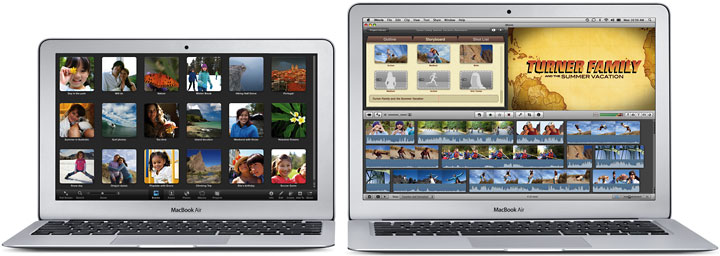Apple updated the MacBook Air in July 2011, migrating to the far more efficient Intel Core i5 and i7 CPUs, adding Thunderbolt connectivity, and going to a 6 GBps SATA Rev. 3 drive bus to further improve SSD performance. Sadly, Apple continued to sell a 2 GB version, which was scarcely adequate for the OS X 10.7 Lion that it shipped with.

That 4 GB option made the Late 2010 MacBook Air a far more viable model going forward. Although 2 GB was adequate to run OS X 10.6 Snow Leopard (the original Mac OS for this model) decently, it would be just sufficient to run OS X 10.7 Lion and insufficient for anything after that. Although Apple claims the Late 2010 MBA supports that current release of OS X (currently 10.11 El Capitan), that is not true for the 2 GB configuration. That just isn’t enough memory.
The 4 GB MBA is far more flexible, and you can comfortably run up through OS X 10.9 Mavericks on this machine. You can install later versions, but they really want more than 4 GB to run decently.
The 11-incher comes in 1.4 GHz 64 GB and 1.6 GHz 128 GB versions, originally retailing at US$999 and $1,199 respectively. The 11″ model is compromised by 3 GB of onboard Level 2 cache (a step backward from the Late 2008, Mid 2009, and the 13″ Late 2010 models), as is the 800 MHz system bus (vs. 1066 MHz in the just-mentioned models).
The 13-incher is a lot more powerful than the 11-inch model with the same 1.86 GHz and 2.13 GHz speeds as the Mid 2009 MBA. The 1.86 GHz model included a 128 GB SSD and retailed for $1,299, while the 2.13 GHz MBA had a 256 GB SSD and sold for $1,599.
Where the 11″ MBA was the slowest set of Intel Macs other than the Early 2008 MacBook Air, the 13″ Late 2010 provides about one-third more processing power than the same speed Mid 2009 models.
Performance
Scores are for the Geekbench 3 64-bit multicore benchmark. You can see that the Core i5 and i7 CPUs make a huge difference compared with the Core 2 Duo CPUs found in earlier MBAs.
- 1.8 GHz 13″ Mid 2011, 4577
- 1.8 GHz 11″ Mid 2011, 4559
- 1.7 GHz 13″ Mid 2011, 4288
- 1.6 GHz 11″ Mid 2011, 3724
- 2.13 GHz 13″Late 2010, 2235
- 1.86 GHz 13″Late 2010, 1981
- 1.6 GHz 11″ Late 2010, 1666
- 1.4 GHz 11″ Late 2010, 1511
The Mid 2011 models are roughly twice as powerful as their immediate predecessors, a huge step forward in performance.
Conclusion
The 4 GB versions of these are good performers and can handily run OS X 10.9 Mavericks from 2013/14. That’s a decent lifespan of support, especially compared to the 2 GB entry-level models that can barely run OS X 10.7 Lion from 2011/12. That’s just a year of OS support, which is the key reason the 2 GB model gets the Road Apple rating.
The 4 GB model can be considered a Limited Mac, because it really can’t run anything after OS X 10.9 well with the amount of memory it has.
Rating
Keywords: #roadapples #mid2011macbookair
Short link: http://goo.gl/kb4F9m

